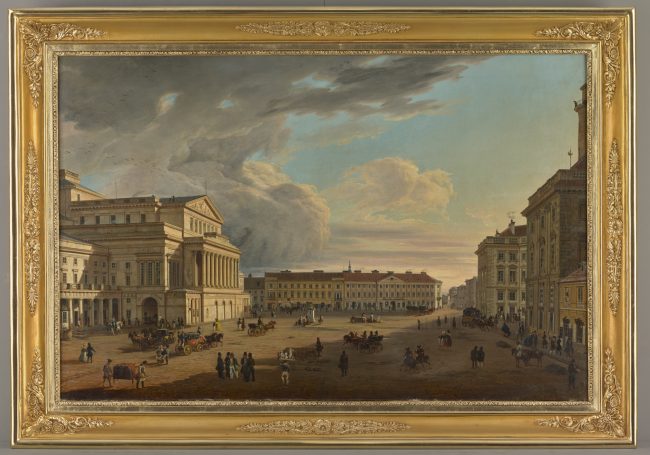
„Plac Teatralny” (Theatre Square)
This work was painted by Marcin Zaleski (1796–1877), an outstanding Polish cityscape painter who created numerous views of Warsaw and of the interiors of Warsaw buildings. Zaleski was a professor at the Warsaw School of Fine Arts and trained many painters who later came to prominence, such as Wojciech Gerson (1831–1901) and Franciszek Kostrzewski (1826–1911).
Immediately after completion, the painting featured at the Fine Arts Exhibition in Warsaw in 1838. It is listed in the catalogue as “The Square in Front of the Grand Theatre (Teatr Wielki)”, complete with a note that reads: “painted from nature.” In 1909, the work served as an opening piece of the artist’s monographic exhibition at the Society for the Encouragement of Fine Arts in Warsaw, which testified to its major artistic value. At the time, it belonged to count Tomasz Zamoyski (1861–1935), owner of the Jabłoń estate in the Parczew County, where the painting likely adorned the palace. The later history of the work is unknown until 1973, when it appeared in the offer of the Desa auction house in Gdańsk and was purchased by the Museum. It graced the main exhibition of the Museum for many years. The view was presented in nine exhibitions in the country and abroad, including the monographic survey of Marcin Zaleski’s work at the National Museum in Warsaw at the turn of 1984. The gilded frame is probably the painting’s original from the 19th century.
The square is portrayed from the side of Senatorska Street in the direction of Bankowy Square. Visible on the left is the classicist edifice of the Grand Theatre. Designed by Antonio Corazzi, it was raised between 1825 and 1833, partly on the site of the demolished 16th-century commercial and residential compound known as Marywil, funded by Queen Maria Kazimiera Sobieska (Marie Casimire de La Grange d’Arquien, Marysieńka, 1641–1716, Queen of Poland 1676–1696). Corazzi turned the Column House, adjacent to Marywil, into the eastern wing of the theatre (visible in the foreground). The architect
added an enormous main corpus with the theatre hall and a twin wing on the western side, complete with the Reduta Halls. Initially, the edifice was to serve as a new seat of the National Theatre. Yet, completed after the fall of the November Uprising, the building could no longer bear that name. Upon an order of Tsar Nicholas I Romanov (1796–1855, Emperor of Russia since 1825, King of Poland 1825–1831), it was named
the Grand Theatre.
Visible in the background – on the corner of Wierzbowa and Senatorska Streets – is the classicist house of the banker and lottery lessee Jan Krzysztof Petyskus. The city hall building closes the square from the right. The former Jabłonowski Palace became seat of the municipal authorities in 1817 after they had relocated from Old Town Market Square. Structured in the second half of the 1820s, Theatre Square was one of the largest and most prominent squares in Warsaw. It was a centre of cultural, administrative and commercial life of the city, as well as a major transport hub.
Running along its northern street front, Senatorska Street connected Castle Square with Bankowy Square, in which new edifices were raised for the government, the Bank of Poland and the Stock Exchange. That period marked the beginning of the process within which the centre of Warsaw shifted south of the Old Town. The Square, initially called Marywil Square, was renamed Teatralny (Theatre) Square around 1840.
Plac Teatralny (Theatre Square)
MARCIN ZALESKI
WARSAW; 1838
OIL ON CANVAS
MHW 18197
81 × 123 CM
Image: ![]()
